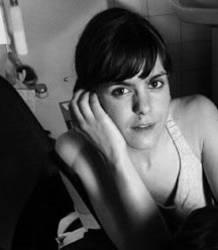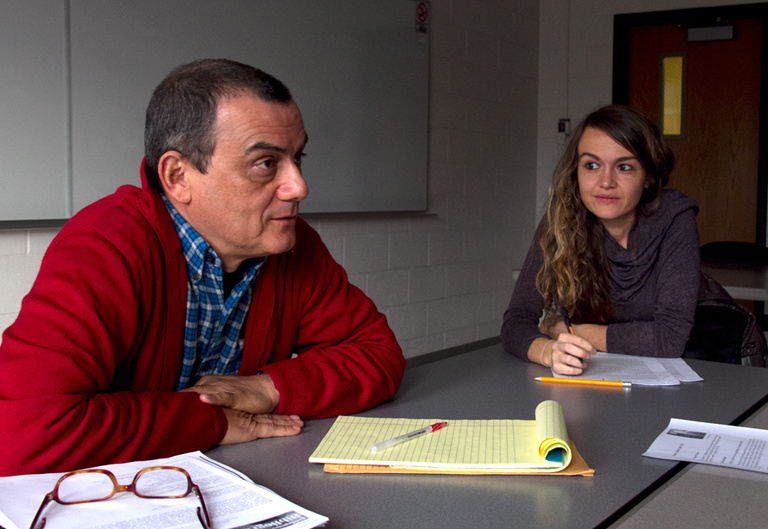For a year, the only thing Paula Lamamie de Clairac Garrido knew about the University of Iowa was its mailing address.

She’d been working as a bookstore clerk in her native Madrid, Spain, when she met Ana Merino, associate professor in the Department of Spanish and Portuguese at the UI, who’d stopped by to collect source texts for her Spanish creative writing classes at the university.
“For months, she had me shipping all these books to the University of Iowa,” Lamamie laughs, “and I didn’t even know what it was. I had no idea it was this famous place for writing.”
Eventually Merino discovered that Paula had a degree in philosophy, wrote poetry and book reviews, danced, and was working on a novel—“so she asked me,” says Lamamie, “‘What are you doing next year?’ Then she told me about the writing program she was developing, and I went online right away to see where Iowa was.”
Lamamie is now a second-year student in the UI’s Master of Fine Arts in Spanish Creative Writing program. Housed in the Department of Spanish and Portuguese in the College of Liberal Arts and Sciences, the two-year program allows Spanish-speaking students to develop their writing talents in their native language while working with established writers from across the Spanish-speaking world.
Core faculty are Merino, the program director and a poet and comics scholar from Spain; Salvadoran writer Horacio Castellanos; and Chilean crime novelist (and, as it happens, newly appointed ambassador to Mexico) Roberto Ampuero. Spanish poet Luis Muñoz and Mexican-American novelist Luis Humberto Crosthwaite are this year’s visiting faculty.
Unique in the Midwest
The UI program—one of only three Spanish-language MFA programs in the U.S.—was conceived in 2009 by decorated Chilean poet and then-UI faculty member Oscar Hahn, who envisioned a creative writing program based on Iowa’s acclaimed workshop model but for students who wanted to read, learn, and write in their native Spanish.
Such a program, he thought, would be well situated at the UI, where it could both draw upon and contribute to the resources and traditions of the “Writing University.” The college recruited Merino to develop the curriculum and outreach component, and in 2011, the Board of Regents, State of Iowa approved the new program. Classes began in spring 2012 with an inaugural student body of two. The subsequent class enrolled five, and the faculty foresee increasing enrollments every year.

“People will come,” says Castellanos. “There’s a lot of writing stimulus in Iowa City. You can’t get that any other place, so concentrated. It’s very attractive to our students”—as is the presence of the UI’s renowned International Writing Program, which regularly hosts, among others, established writers from Latin America.
So far, the new MFA program has enrolled students from Colombia, Bolivia, Spain, and Costa Rica—and they’re quickly becoming a fixture in the local writing community, giving and attending readings; teaching Spanish classes at the UI as teaching assistants; leading free workshops via the program’s outreach arm, the Spanish Creative Literacy Project; and collaborating with fellow artists across the university.
Spanish at Iowa
“I’m loving it,” says Lamamie. “It’s good to be here with so many wonderful writers, and it is so rich to be writing in my own language. I like English, but those words don’t have special meanings for me because it’s not my native language. But when I write in Spanish, I can use a word because it reminds me of something my grandmother would say.” Plus, she says, “In English, maybe I have one or two adjectives to describe something, but in Spanish, I have twenty.”
English proficiency is required of all students in the Spanish Creative Writing Program (it’s requisite for admission to the UI Graduate College), though the students write in Spanish, and their instructors teach in Spanish—with, that is, the occasional exception of certain assigned readings: “When we read Flannery O’Connor,” winks Castellanos, “we read in English, not Spanish translation.”
The Writer as Artist
The program’s students are required to take classes in a variety of writing forms, including the short story, the graphic novel, poetry, detective narrative, screenplays, memoir, and children’s literature. Exposing students to multiple genres was a priority for Merino in developing the curriculum, for practical as well as cultural reasons.
Most of the program’s graduates, she says, will teach creative writing at one time (or place) or another and will need to be prepared to teach a variety of genres. “But also,” Merino observes, “in the Hispanic tradition, writers are very flexible. Was Borges a poet or a fiction writer? He was both. Lorca—was he a dramaturge or a poet? Again, both. Even Cervantes—everyone knows him as a fiction writer, but he also wrote amazing theater. A writer is someone with a passion for writing, and if you have the opportunity to see different ways of writing, you will be a better writer.”
![span1.jpg Castellanos, Roure, Sebastián Velasquez, and Iván Parra [left to right] workshop a piece of writing.](/sites/now.uiowa.edu/files/styles/no_crop__768w/public/2023-04/span1.jpg?itok=7FlVYk8Q)
The breadth of the curriculum seems natural to Lamamie, who notes that Hispanic cultures tend to view art holistically: “In many parts of the Spanish-speaking world, the distinction between the arts is not so clear. You are a writer more than you are a poet or a novelist, and you are an artist more than you are a writer.”
It is partly for this reason that the program’s students are encouraged to explore a range of creative interests via electives. Lamamie, for instance, has taken several courses in the Center for the Book and the college’s department of dance, noting that “the subjects are very different, but they are interconnected. When you are improvising a piece of dance, it is similar to writing a poem.”
A Tradition of Sharing
In addition to 48 semester hours of coursework and a thesis, the MFA in Spanish Creative Writing—unique among the UI graduate writing programs—requires participation in community outreach activities.
“When you’re a writer,” says Merino, “it’s not about isolating yourself and saying ‘I am The Writer!’ It’s about sharing your passion for writing and reading with other people.”
She describes a tradition from her native province of León, Spain, called filandón, where people gather after dinner and tell each other stories: “For me, growing up, writers were not hidden. They were part of the community, telling us stories.”
Naturally, when asked to direct the MFA program, she founded an outreach initiative, the Spanish Creative Literacy Project, to train students in creative service to the community and help local Hispanic adults and children tell their stories. Recently, Merino and two of the program’s student writers conducted a free cuentapoemas activity for children, using illustrations to tell the story of a poem.
As part of this effort to share, promote, and showcase creative writing across the Spanish and Latin American world, the program will launch an online Spanish-language literary magazine in spring 2013, in conjunction with the UI’s Digital Studio for Public Humanities. Iowa Literaria will feature Spanish-language writing by established authors as well as from students in the program.
“The journal will allow us to be in touch with the writers’ community in Spanish,” notes editor-in-chief Castellanos—“writers of every level and every kind of creative expression. New generations will be able to go directly to the magazine to see new things, and prospective students can read it when they’re considering applying.” The journal will also maintain a blog to cover the program’s outreach activities.
“As a new program, we’re surfing on the wave of Iowa’s writing traditions,” he says, “but we want to contribute as well, andIowa Literaria is part of that.”
For more information or to apply to the MFA in Spanish Creative Writing program, visit clas.uiowa.edu/dwllc/spanish-portuguese/graduate-programs/mfa-spanish-creative-writing.